This weekend, Carolyn and I travelled up the M5 to Weston Super Mare in Somerset to spend some time with Will, his girlfriend Olivia (Ollie), and her parents and Grandad as we enjoyed a Friday evening barbeque followed by a day out on the water on Saturday, on the paddle steamer Waverley which we were due to catch from the old Victorian pier in Clevedon, just up the coast, the following morning.
The journey up to Weston wasn't much to write home about as a trip that would normally take about an hour ended up taking three, with horrendous holiday traffic bringing progress down to a stop-start affair that left the both of us quite tiered when we finally arrived; and were able to relax over a drink and some very nice food combined with some of the best summer weather we have yet enjoyed here in the west country this year.
The next morning, feeling much better after an English breakfast at the hotel, we made the short drive to Clevedon and parked up close to the seafront for a ten minute walk along the old promenade towards the pier where we had arranged to meet up before joining the queue to board the ship.
I grew up in the area when I was a little lad, living in what was then, in the early sixties, the small village of Nailsea, with Clevedon and Weston very familiar towns, and so it was quite a reminiscence for me to walk along Clevedon's promenade overlooking the sea filled lido and gazing out towards South Wales on the horizon across the mouth of the River Severn.
As we got nearer to the old pier, the distant sound of bagpipes was carried on the warm morning summer breeze and out on the horizon I could just make out our vessel for the day's adventure, made clearer with the telephoto on the camera as PS Waverley made her way up the river preparatory to swinging round to starboard to make her approach to the foot of the pier.
Built during the 1860s to attract tourists and provide a ferry port for rail passengers to South Wales, the pier is 1,024 feet (312 metres) long and consists of eight spans supported by steel rails covered by wooden decking, and with a pavilion on the pier head.
The pier served as an embarkation point for paddle steamer excursions for almost one-hundred years, and two of the spans collapsed during stress testing in 1970 when demolition was proposed, but thanks to local fund raising and heritage grants the pier was dismantled for restoration and reassembled.
It reopened in 1989, and ten years later was awarded the Pier of the Year from the National Piers Society, and a Civic Trust Award, and now offers a landing stage for steamers and is also a popular attraction for tourists and anglers.
The paddle steamer Waverley is the sixteenth Clyde-built vessel to be named after Scottish novelist and poet Sir Walter Scott’s (1771-1832) first novel published in 1814, and so it was perfectly fitting to have a welcoming skirl from a suitably acquired piper as we stood in line amid the babble of chatter among happy folks waiting to board and enjoying a Glorious First of June summer day and, with Lord Howe in mind, a fitting one for any confirmed Englishman to be out on the water.
The current day 693 tonne Waverley was ordered by the London and North Eastern Railway (LNER) to replace an earlier Waverley, built in 1899 by A & J Inglis of Glasgow, that served in the both World Wars as a minesweeper before being sunk by aircraft on 29th May 1940 during the evacuation of troops from Dunkirk.
Also built by Inglis at the same Pointhouse yard, her keel being laid on the 27th December 1945 and launched on 2nd October 1946 by Lady Matthews, the wife of the Chairman of the LNER, she entered service on the 16th June 1947, working the LNER’s Firth of Clyde steamer route from Craigendoran Pier, near Helensburgh, up Loch Long to Arrochar, bearing the company’s red, white and black funnel colours in her first year in service.
 |
| The keel of PS Waverley being laid on the 27th December 1945 |
She is now proudly owned by Waverley Steam Navigation Company Ltd., a registered charity, and is the ‘Sole Survivor’ - the very last of the great Clyde paddle steamers, restored to her 1947 appearance and operated on a not-for-profit basis which relies on public support to keep her sailing.
 |
| The majestic lines of PS Waverley echo another age as she slowly makes her approach to the steps of Clevedon Pier. |
Our voyage was planned to head out between the English and Welsh islands of Steep and Flat Holm before turning in towards the South Wales coast and a stop off at Penarth where passengers planning an afternoon in the town would disembark and where those planning to join us for the journey back to Clevedon would come aboard, before we set course for Portishead before swinging down along the Somerset coast back to Clevedon, arriving mid afternoon.
As we moved further out into the channel Cardiff became clearer through the summer morning haze.
The island is now uninhabited, with the exception of the wardens and is protected as a nature reserve and Site of Special Scientific Interest (SSSI) with a large bird population and plants including wild peonies.
There was a signal station or watchtower on the island in Roman times, but there may have been human habitation as early as the Iron Age, and in the 6th century it was home to St Gildas, a British monk best known for his account, De Excidio et Conquestu Britanniae, of the Britons before and after the arrival of the Saxons.
In the 12th and 13th centuries it was home to a small Augustinian priory and in 1832 an inn was built and used for holidays in the 19th century, after which a bird sanctuary was established in 1931.
.jpg) |
| Split Rock Battery, Steep Holm - Picture by Chris Allen |
After passing Steep Holm, her opposite number, Flat Holm came closer into view as we circumnavigated the southern half of the island.
 |
| Passing Flat Holm to the south, with its prominent light house in view. |
A sanatorium for cholera patients was built in 1896 as the isolation hospital for the port of Cardiff.
 |
| British Post Office engineers inspect Guglielmo Marconi's wireless telegraphy (radio) equipment, during a demonstration on Flat Holm island, 13 May 1897. |
 |
| Grandpa Fred Jones worked for Marconi in London |
With frequent shipwrecks, a lighthouse was built on the island, which was replaced by a Trinity House lighthouse in 1737.
Nine Rifled muzzle loaders (RMLs) on disappearing Moncrieff carriages were built at the Royal Gun Foundry, Woolwich and were mounted in four separate batteries, all in Moncrieff pits, 7 feet (2 metres) in diameter and 10 feet (3 metres) deep, constructed of limestone blocks and bricks, having the advantage of being almost invisible to shipping and increased protection to the gun crews.
Because of its strategic position on the approaches to Bristol and Cardiff a series of gun emplacements, known as Flat Holm Battery, were built in the 1860s as part of a line of defences, known as Palmerston Forts and there are remains of four battery sites on the island built around emplacements for Montcrieff 'disappearing gun'.
 |
| Montcrieff 'disappearing gun' as installed on Flat Holm island in 1800's |
 |
| On Flat Holm, an RML (Rifled Muzzle Loaded) 7 inch 7 ton Mk III gun adjacent to the lighthouse. https://commons.wikimedia.org/wiki/File:Flat_Holm_Canon.jpg |
On the outbreak of World War II, the island was rearmed with four 4.5-inch guns and associated searchlights for anti-aircraft and close defence, together with two 40mm Bofors guns.
A GL (Gun Laying) Mk II radar station was also placed in the centre of the island with the structures forming part of the Fixed Defences, and protected the Atlantic shipping convoys between Cardiff, Barry, and Flat Holm.
The foghorn building is a Grade II listed building and was built by Trinity House in 1906.
The siren was originally powered by an 11 kW (15 hp) engine, which gave two blasts in quick succession at two-minute intervals that could be clearly heard by people living on both coasts but for many years following World War II, the foghorn was heard as one long and one short blast and nautical almanac data as at 1965, stated that the interval was 1.5 minutes.
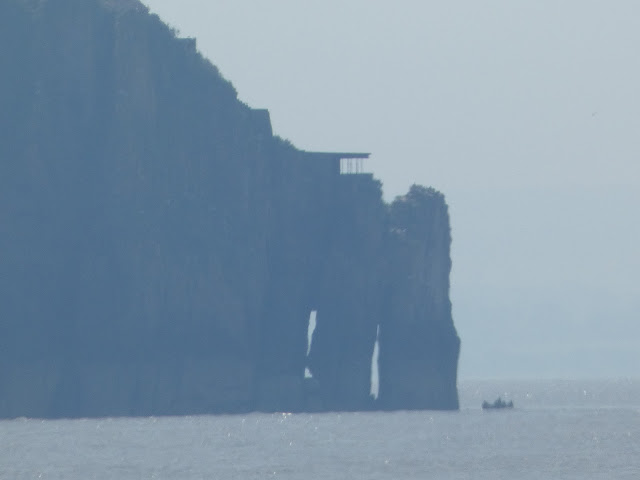 |
| The 1941 built Battery Observation Post on Steep Holm at the appropriately named Rudder Rock. |
Rounding the western tip of Flat Holm we soon had Penarth in view with its waterside buildings standing out behind the promenade and pier for which we were headed to collect the long line of new passengers queued up awaiting our arrival.
 |
| Penarth and its pier, our next stop. |
As my pictures might suggest the sky was decidedly more cloudy at Penarth and we were soon donning the odd extra layer to compensate the lack of direct sun, but Penarth still made for a very picturesque backdrop to the Waverley, as folks boarded and disembarked, and we took the opportunity to head below decks to enjoy some fish and chips before returning topside for the sail home.
After lunch at Penarth, I took the opportunity to explore the ship and see more of her history, design and facilities.
Below deck there was a really good information area with notice boards explaining the history of these old paddle steamer ferries, Waverley and in particular her predecessor.
 |
| Waverley (1899) before World War One |
With the advent of the railway, trains became the popular mode of transport for holiday makers around the UK in the late 19th and early 20th centuries but seeing paddle steamers becoming a popular alternative, and seeing the railway companies building substantial fleets of these small coastal steamships to meet the demand, offering combined tickets between places such as the Isle of Arran and Man and Isle of Wight and of course Ireland.
During both World Wars these paddle steamers were requisitioned for military use often serving as minesweepers where their shallow draught enabled them to operate close inshore, and seeing the larger ships pressed into service as troopships.
Through the war years HMS Waverley (pennant number 932) served mainly on the English south and Belgian coasts, and her promenade deck was extended forward, the bow was plated, glass windows were removed and plated over, minesweeping equipment was added to her stern and armaments were added including a 12 pounder gun on her bow. Waverley was released from service in April 1919 and spent the next fourteen months being converted back from war service. The changes the Admiralty had made to the bow were retained, and the bridge was brought forward in front of her funnel giving her a similar appearance to newer paddle steamers of that time. She resumed her services to Rothesay in July 1920, with trips up to Arrochar and Loch Goil.
Post war British holidaymakers once again flocked to the British seaside, with the paddle steamers able to play a role alongside the train and the increasing use of cars to transport folks to their chosen resort or excursion; however after a revival of fortunes in the 1950s, the 1960s saw a gradual change in holiday habits with the growth in car ownership heralding a revolution in the design of coastal ferries and the need to carry as many cars and commercial vehicles as possible with designs referring back to the tank landing ships deployed on D-Day at the end of WWII.
The main crank is solidly attached to both paddle wheels so they cannot turn independently, thus the Waverley has a much larger turning circle than modern ferries.
Returning topside I joined everyone as we made our way to the bow to enjoy the sights as we worked our way along the coast in preparation for docking alongside the Clevedon pier.
She changed hands as the British railway companies were merged into the London and North Eastern Railway in 1923, was replaced as the fleet’s flagship in 1931 by the newer PS Jeanie Deans, was remodelled in 1933 to modernise her internal and external accommodations, and finally in 1939 she was removed from service and laid up in Bowling Harbour.
Between the 26th of May and 4th of June 1940, with German troops encircling the British Expeditionary Force in Belgium, an armada of eight-hundred ships was sent to Dunkirk to evacuate the troops under the codename 'Operation Dynamo' for which twenty-three paddle steamers drawn from all corners of Britain, made the dangerous crossing to Dunkirk.
With their high capacity and shallow draught enabling them to get close to the beaches, they made a valuable contribution that would see some 338,000 men rescued during this remarkable operation.
 |
| Waverley on her final voyage at Dunkirk, 29th May 1940. |
Re-requisitioned for war as a minesweeper, Waverley took part in Operation Dynamo and on the 29th of May having already rescued 400 men from the beaches and now on her second trip, she was hit by three bombs and sank rapidly with the loss of 350 lives for which the plaque on the main deck seen above commemorates.
Britons started to look abroad for holiday destinations, with air travel starting to develop accordingly and seeing the decline of the British holiday market and foot passengers using trains leading to the closure of many small piers and ferries.
But maybe there might be a resurgence of interest yet in these wonderful small ships and the unique way of travelling and sight seeing they offer to a new generation of British holidaymaker looking to explore and enjoy the delights Britain can offer in summer.
Continuing my exploration around the ship I found my way to the engine room between the two paddlewheel casings with a passageway each side allowing passengers to watch the engine and cranks shaft in action, and I have added a link to a short video covering our trip that includes a look at the engine in action, see below.
Waverley is powered by a three-crank diagonal triple-expansion marine steam engine built by Rankin & Blackmore, Engineers, Eagle Foundry, Greenock, Scotland and is rated at 2,100 IHP, achieving a trial speed of 18.37 knots (34.02 km/h; 21.14 mph) at 57.8 rpm.
We had had a splendid day courtesy of the crew and shore support team for PS Waverley, and arrived back at Clevedon with a welcoming afternoon sun high in the sky and in good time for a pleasurable promenade along Clevedon front to enjoy an ice cream before returning home tiered but very nicely-so, after such a great day.
 |
| https://waverleyexcursions.co.uk/ https://paddlesteamers.org/ |
As mentioned the Waverley and other ships in the collection of the PSPS are enabled to be kept running thanks to public support through charitable giving and booking trips on these amazing ships so I would recommend checking them out and doing something similar if you fancy a great day out
As mentioned, I've posted a short video on my YouTube Channel showing some clips of the ship during our day, link below.
As always, more anon
JJ

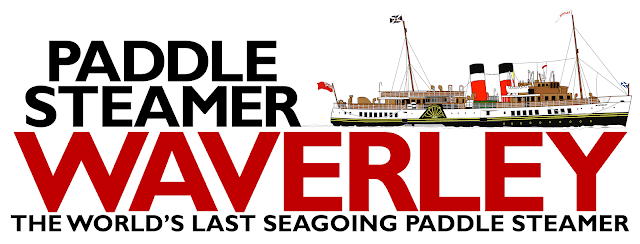




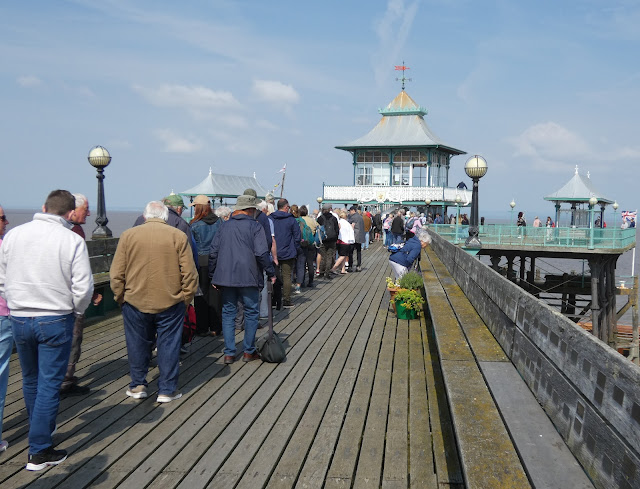




















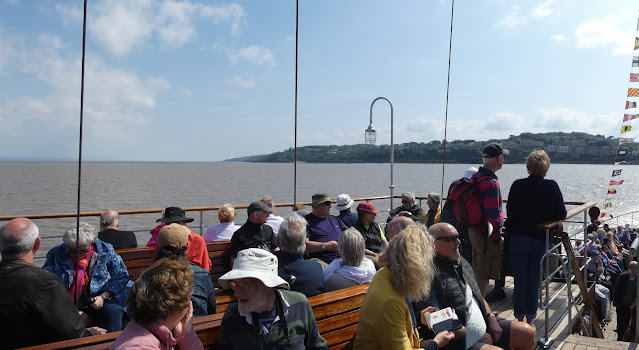















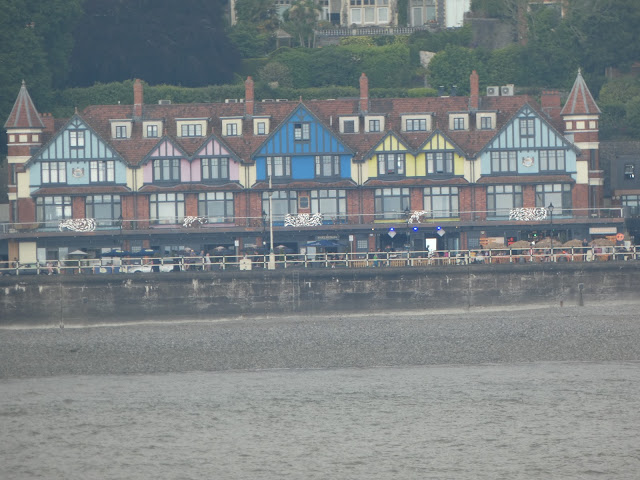

























No comments:
Post a Comment